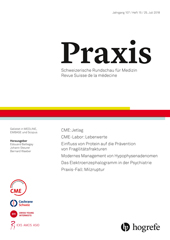Abstract
Zusammenfassung. Das Elektroenzephalogramm (EEG) bietet eine non-invasive und kostengünstige Methode zur elektrophysiologischen Erfassung neuronaler Aktivität. Die im EEG nachweisbaren Pathologien erlauben mit hoher Sensitivität, aber begrenzter Spezifität einen Rückschluss auf einen abnormen Funktionszustand des Gehirns. Psychiatrische Hauptindikationen des EEGs stellen eine atypische klinische Präsentation eines neuropsychiatrischen Syndroms, die untypische Reaktion auf eine Medikation und die Basisdiagnostik vor Beginn einiger Medikamente bzw. Stimulationsverfahren dar. In der aktuellen Forschung hat das EEG nicht nur im Hinblick auf Diagnostik, sondern vor allem auf die Vorhersage des Behandlungserfolges verschiedener therapeutischer Ansätze Aufmerksamkeit auf sich gezogen. Der folgende Artikel behandelt unter anderem Elektrophysiologische Grundlagen des EEGs, EEG-gestützte Differenzialdiagnostik verschiedener Krankheitsbilder und neue Forschungsansätze in Diagnostik und Therapieplanung.
Abstract. The electroencephalogram (EEG) is a non-invasive and cost-effective method to monitor spontaneous neuronal activity over time. Pathologies in EEG recordings indicate with high sensitivity but low specificity abnormal functional brain states. The main psychiatric indications for EEG recordings include atypical clinical symptoms of a neuropsychiatric syndrome or atypical reactions to medication as well as a baseline diagnostic before starting treatment with specific drugs or stimulation modalities. In recent research the EEG continues to be a valuable tool not only in diagnostics but also for the prediction of treatment success. The following paper focuses on basic electrophysiological understanding of EEG recordings, the diagnostic value of EEG recordings in different clinical entities, and new research attempts in diagnostic and treatment prediction.
Résumé. L’électroencéphalogramme (EEG) est une méthode non invasive et économique permettant d’observer l’activité électrique spontanée des neurones. Les pathologies détectées par cette méthode permettent de tirer des conclusions très sensitives mais moins spécifiques sur le fonctionnement anormal du cerveau. Les indications principales psychiatriques établies par un EEG sont: symptômes cliniques atypiques de syndrôme neuropsychiatrique et réactions atypiques à une médication. Cette méthode est également utilisée pour l’établissement de diagnostics et mesures de référence prétraitement par médication ou technique de stimulation. L’EEG continue à être un outil précieux dans les études récentes, non seulement pour l’établissement de diagnostics, mais aussi dans la prédiction du succès d’essais thérapeutiques. Ce papier se concentre sur l’analyse électrophysiologique basique des EEG, la valeur des diagnostics établis par l’EEG dans différentes situations cliniques et les nouveaux essais en diagnostic et prédiction de traitements.
Bibliografie
; IPEG Pharmaco-EEG Guidelines Committee: Guidelines for the recording and evaluation of pharmaco-EEG data in man: the International Pharmaco-EEG Society (IPEG).
Neuropsychobiology 2012; 66: 201–220.: Quantitative EEG changes induced by anticholinergic drugs and their behavioral correlates in man.
Recent Adv Biol Psychiatry 1965; 8: 151–173., EEG abnormalities in patients with atypical panic attacks.
J Clin Psychiatry 1995; 56: 358–362.: Electroencephalogram abnormalities in panic disorder patients: a study of symptom characteristics and pathology.
Biopsychosoc Med 2010; 4: 9., : Is there a pathophysiological and therapeutic link between panic disorder and epilepsy?
Acta Psychiatr Scand 1995; 91: 430–432.: The diagnostic value of clinical EEG in detecting abnormal synchronicity in panic disorder. Clin. EEG Neurosci.
Clin EEG Neurosci 2011; 42: 166–174.: Failure to recognize psychogenic nonepileptic seizures may cause death.
Neurology 2004; 62: 834–835.: Psychogenic nonepileptic seizures: review and update.
Epilepsy Behav 2003; 4: 205–216.,
Nonepileptic Seizure Task Force : Nonepileptic psychogenic status: markedly prolonged psychogenic nonepileptic seizures.Epilepsy Behav 2010; 19: 65–68.: Improved health care resource utilization following video-EEG-confirmed diagnosis of nonepileptic psychogenic seizures.
Seizure 1998; 7: 385–390.: The diagnosis of psychogenic non-epileptic seizures: A review.
Seizure 1997; 6: 243–253., : Nonconvulsive status epilepticus: Epilepsy Research Foundation workshop reports.
Epileptic Disord 2005; 7: 253–296.: Nonconvulsive status epilepticus after electroconvulsive therapy: a review of literature.
Psychosomatics 2018; 59: 36–46.: The alcohol withdrawal syndrome.
Lancet 1997; 349: 1897–1900.:
Neurophysiologische Untersuchungsmethoden in der Psychiatrie . In: Psychiatrie, Psychosomatik, Psychotherapie. Berlin: Springer; 2015. 1–27. doi: 10.1007/978-3-642-45028-0_28-1: Utility of EEG in delirium: past views and current practice.
Int Psychogeriatr 1991; 3: 211–229.: Elektroenzephalographie in der Psychopharmakotherapie. In:
Handbuch der psychiatrischen Pharmakotherapie . Berlin: Springer; 2012. 399–415. doi: 10.1007/978-3-642-19844-1_39: Electrophysiological assessment of neuropsychiatric disorders.
Semin Clin Neuropsychiatry 2002; 7: 30–41.: Electroencephalography as a diagnostic instrument in Alzheimer’s disease: reviews and perspectives.
Int Psychogeriatr 1997; 9 (Suppl 1): 237–246; discussion 247–252.: EEG extreme delta brush: An ictal pattern in patients with anti-NMDA receptor encephalitis. Epilepsy Behav 2015; 49: 280–285.
: Extreme delta brush: a unique EEG pattern in adults with anti-NMDA receptor encephalitis.
Neurology 2012; 79: 1094–1100.: EEG in der Psychiatrie.
Neurophysiol-Labor 2017; 39: 116–128.: EEG changes associated with autistic spectrum disorders.
Neuropsychiatr Electrophysiol 2015; 1: 3.: Proconvulsant effects of antidepressants – What is the current evidence?
Epilepsy Behav 2016; 61: 287–291.: Antipsychotic drug use and the risk of seizures: follow-up study with a nested case-control analysis.
CNS Drugs 2015; 29: 591–603.: Kompendium der Psychiatrischen Pharmakotherapie. Berlin: Springer; 2017.
: EEG-Veränderungen und epileptische Anfälle unter Psychopharmakotherapie.
Neurophysiol-Labor 2017; 39: 95–102.: Seizure incidence in psychopharmacological clinical trials: an analysis of Food and Drug Administration (FDA) summary basis of approval reports.
Biol Psychiatry 2007; 62: 345–354.: Merits of EEG monitoring during ECT: a prospective study on 485 patients.
Indian J Psychiatry 2002; 44: 24–28.: Quantification of EEG changes following electroconvulsive therapy in depression.
Eur Arch Psychiatry Neurol Sci 1987; 236: 209–213.: Safety of rTMS to non-motor cortical areas in healthy participants and patients.
Clin Neurophysiol 2006; 117: 455–471., The reliability of the diagnostic features in patients with narcolepsy.
Biol Psychiatry 1996; 40: 208–214.: The vigilance regulation model of affective disorders and ADHD.
Neurosci Biobehav Rev 2014; 44: 45–57., : CNS- and ANS-arousal predict response to antidepressant medication: Findings from the randomized iSPOT-D study.
J Psychiatr Res 2016; 73: 108–115., : EEG connectivity between the subgenual anterior cingulate and prefrontal cortices in response to antidepressant medication.
Eur Neuropsychopharmacol 2017; 27: 301–312.: Predicting sex from brain rhythms with deep learning.
Sci Rep 2018; 8: 3069.



